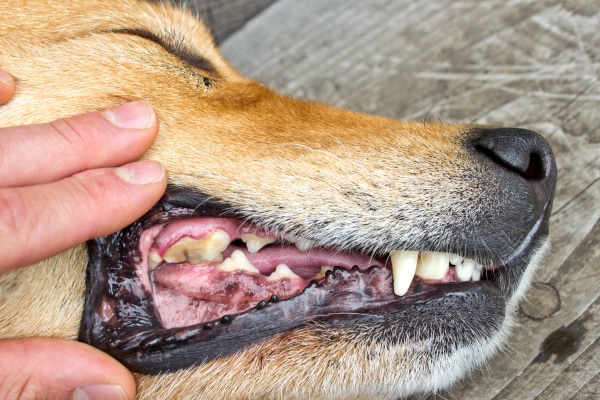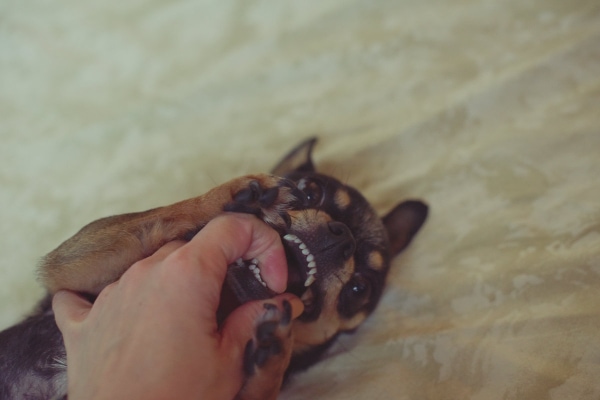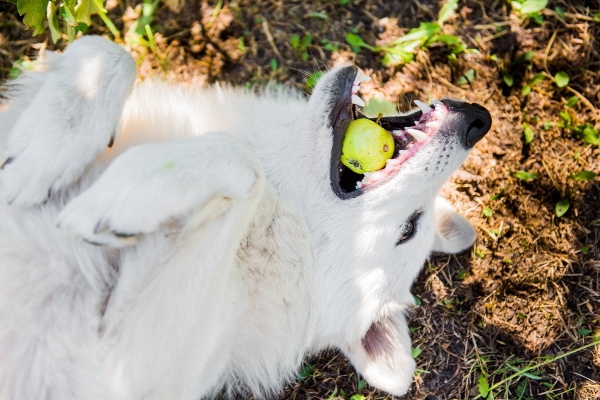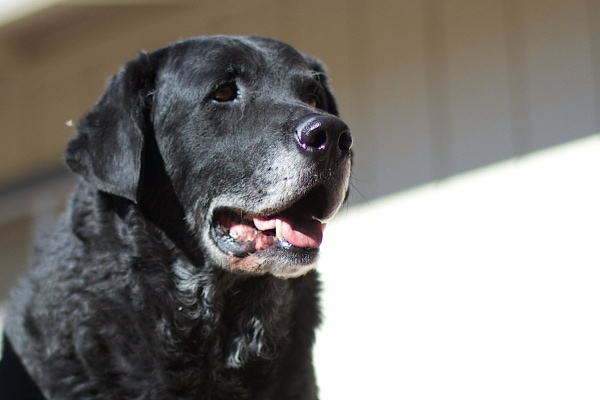Is your dog choking? Integrative veterinarian Dr. Julie Buzby provides guidelines to help you recognize choking and gives clear step-by-step instructions for performing the Heimlich maneuver and the eXternal eXtraction Technique (XXT) on your dog. Plus, she discusses five conditions that look like choking but do not involve an object obstructing the airway.

Witnessing a dog choking is terrifying.
Have you ever thought about what you’d do in this scenario?
At that moment, you’d need to remain calm. You’d need to determine if your dog is choking versus experiencing a condition that looks like choking. And then you’d need to know how to intervene in the rescue.
And that is exactly what I hope to teach you.
How to help a choking dog
True choking occurs when an object is partially or completely obstructing your dog’s airway. You may notice that your dog shows the following choking signs:
- Acting restless, anxious, or distressed
- Making repetitive coughing, hacking, or gagging noises
- Pawing at the face or mouth
- Gasping for air or making loud rasping noises
- Collapsing or becoming unconscious
- Turning blue or pale
- Retching or trying to vomit
If you see these symptoms and suspect that your furry friend is choking, follow these steps:
1. Remain calm
I know it is difficult, but it is important to try to stay as calm as possible. Take a few deep breaths and tell yourself “I can do this!”
Then quickly assess your surroundings. When it comes to true choking, time is of the essence. So unless you are in an unsafe location (such as crossing the road), stop and attend to your dog where you are rather than trying to move him or her.
2. Assess your dog
Next, you will need to check your dog’s status. Start by lifting his or her lips so you can check the gum color. Normal, healthy gums should be bright pink. But pale or bluish-purple gums can be a sign your dog isn’t getting enough oxygen.

3. Check the mouth
While checking gum color, you can also carefully look in your dog’s mouth. Is there any evidence of bleeding? Can you see a foreign object inside the mouth or throat, like a piece of a toy or a stick?
If your dog is calm and choking but still breathing, he or she may allow you to attempt to remove the object. Be very careful not to get bitten while doing this, though. And do not attempt to sweep the back of the mouth with your fingers if your dog is conscious. This may push the object back further, and even the nicest dogs may accidentally bite when scared or in pain.
If your dog has a complete airway obstruction, he or she may become weak or collapse. While scary, this does make it easier to evaluate the mouth and check the back of the throat. You may even be able to sweep your fingers in the back of the mouth to remove any objects physically blocking the trachea.
As a caveat for either situation, if a small sharp object is lodged in your dog’s throat (e.g. a sewing needle or fishing hook), don’t attempt to remove it yourself. Instead, take your dog to your regular vet or an urgent care vet for assistance.

4. Perform the Heimlich maneuver or eXternal eXtraction Technique (XXT)
If the item is firmly stuck in the back of the throat, or if you suspect a small piece of something has become lodged in the trachea, you may need to perform a choking rescue maneuver. The two main options are the Heimlich maneuver or the eXternal eXtraction Technique.
If the object is a large round ball and your dog is unconscious, you may need the eXternal eXtraction Technique. Otherwise, follow these steps to perform the Heimlich maneuver.
Many pet parents are familiar with this maneuver in humans. But the approach is slightly different for our canine friends. There are essentially two ways to perform the Heimlich maneuver in dogs.
Heimlich maneuver on a standing dog
- Start by standing behind your dog while he or she is standing (or crouch if the dog is small).
- Place your arms around the dog’s belly and then make a fist with one of your hands.
- Center your fist over the center of your dog’s stomach and just behind the rib cage.
- Place your opposite hand over your fist to cover it.
- With a thrusting motion, sharply pull your hands in and upward toward yourself.
- Check the mouth to see if the object has dislodged. If not, repeat these steps again.
Heimlich maneuver on a lying down dog
- If the dog is lying down (or unconscious), position yourself behind the dog’s back.
- Place one hand on the dog’s back to steady him or her while placing your other hand on the dog’s belly, just below the rib cage. This hand should be curled into a fist.
- Apply pressure with your fist by pressing inward and thrusting it up toward the head.
- Alternatively, if the dog is small, you may be able to use an open hand to squeeze the belly. Or for a large dog, you may be able to use open hands to push firmly on the rib cage.
- Check the mouth to see if you have freed the object. If not, repeat these steps again.
The eXternal eXtraction Technique (XXT)
Some objects, like a rubber ball, may be much trickier to remove. Smooth round objects can slip into the back of the throat, making them difficult to retrieve with your hands or with forceps. Sometimes, even the Heimlich maneuver might fail to expel the stuck item.

Thankfully, there is now another technique available to help these dogs. It is called the eXternal eXtraction Technique (XXT). And it is used in fully unconscious dogs with complete airway obstructions. However, XXT can be more difficult to perform than the Heimlich maneuver, so your veterinarian may be better suited to use this technique.
In order to perform XXT, place the dog flat on his or her back with the top of the head against the floor or table. This positions the airway parallel to the floor, which makes it easier to dislodge stuck objects. Then follow these steps:
- Straddle the dog but do not place your full weight on him or her
- Make a diamond shape with your index fingers and thumbs. Then place the index fingers on the “V” of the jaw.
- Palpate the object with your thumbs through the skin and position the thumbs just behind it.
- Press the thumbs down and then up as if in the shape of the letter “J” until the stuck item ejects from the throat.
- Once the item has been removed, provide two rescue breaths.
- If there is no response, initiate CPR.
(For a helpful video, check out Veterinary Partner’s article on eXternal eXtraction Technique (XXT).)
5. Take your dog to the vet
If you are not successful in dislodging the object after a few attempts, start heading to the emergency clinic for an emergency vet visit (or call your regular vet and let them know you are on the way with a choking dog). They have more tools at their disposal too, hopefully, get the object out and stabilize your dog.
Even if the Heimlich or XXT is successful, it is often still best to take your dog to the vet. The act of removing the object can sometimes cause damage to your dog’s throat. And dogs who have an upper airway obstruction may develop non-cardiogenic pulmonary edema (i.e. fluid in the lungs that is not a result of heart failure) or other dangerous complications.
5 reasons dogs sound like they are choking but actually aren’t
I wanted to cover the first-aid aspect first because if you think your dog is choking, you need to find out what to do ASAP. But I also think it is important for dog parents to be aware of the situations where the steps we discussed above are not indicated.
Thankfully, true choking is fairly rare. Certainly, dogs can have an airway obstruction from a toy, food item, or other object. But more often than not, what you are dealing with is a “choking impostor.” So let’s take a look at five of them now.

1. Reverse sneezing
The first time you see and hear reverse sneezing in dogs, it can be quite concerning. And may lead you to ask, “Is my dog choking?” Thankfully though, reverse sneezing is not an emergency, and your dog is not actually choking.
Dogs can sneeze “normally” just like humans. But they can also “reverse sneeze.” This loud snorting sound occurs in response to inflammation in the back of the nose. It can be triggered by things like allergies, environmental stimuli, or even turbulent airflow through the nasal cavity. (Think about how often you’ve seen a reverse sneeze when your dog lies upside down).
Fortunately, dogs can still breathe while this happens, even if it might stop your pup in his or her tracks for a moment. These episodes may last a few seconds or up to a minute or two and will resolve on their own.
However, it is still a good idea to monitor how often your dog has reverse sneezing episodes. And talk to your vet if it occurs frequently. Sometimes, conditions that may require treatment (e.g. foreign objects, nasal mites, infections, and nasal tumors) can also trigger reverse sneezing.
2. Brachycephalic obstructive airway syndrome
Sometimes brachycephalic dog breeds (i.e. those with stocky bodies and short noses) may have a combination of anatomical issues that can cause difficulty breathing, especially when exercising, excited, or experiencing hot or humid weather. This can lead to the dog sounding like he or she is choking, snorting, wheezing, snoring, or gagging.

The conformational issues include:
- Elongated (+/- thickened) soft palate
- Stenotic nares
- Hypoplastic (i.e. narrow) trachea
- Everted laryngeal saccules
A brachycephalic dog’s tiny nostrils (i.e. stenotic nares) create negative pressure in the throat during inhalation. (Think about trying to suck something up through a skinny straw). This can pull the tissue at the top of the trachea (i.e. the laryngeal saccules) into the tracheal opening, which narrows the airway.
Plus, the negative pressure in the throat causes stretching of the already elongated soft palate. As a result, the back edge of the soft palate can get sucked into the opening of the trachea, further obstructing airflow. The combination of these abnormalities can also lead to swelling and inflammation of the throat. This makes breathing even more difficult.
If you have a brachycephalic dog, you probably have a pretty good idea of what normal breathing looks and sounds like for him or her. So if you are ever concerned about your dog’s breathing, it is best to contact your veterinarian immediately. The vet can help stabilize your dog in the short term. And then he or she can discuss the various surgical procedures that can help a dog with brachycephalic airway obstructive syndrome breathe more easily.
3. Tracheal collapse
Middle-aged and senior dogs, especially toy and miniature dog breeds (e.g. Pomeranians, Chihuahuas, Shih Tzus, and Toy Poodles) can sometimes sound like they are choking if they have a collapsed trachea in dogs.
A normal trachea is comprised of flexible, cartilaginous “C” shaped rings that are covered with a thin membrane of soft tissue. As dogs age, the rings become more inflexible and can collapse, narrowing the windpipe. Also, part of the soft tissue membrane that isn’t supported by the tracheal rings can sink and collapse inward, further reducing airflow.
As a result, the dog may have a goose-honking cough or make choking sounds. Sometimes dogs with tracheal collapse can even go into respiratory distress, which is a medical emergency.
While there isn’t a true cure for collapsing trachea, there are some surgical, medical, and lifestyle modifications that can reduce the effects of the collapsed trachea. Your veterinarian can help you determine the right course of action for your dog.
4. Laryngeal paralysis
Sometimes an old dog coughing and gagging or acting like he or she is choking can be a result of laryngeal dysfunction. Normally, the larynx, which is located at the top of the trachea, uses several flaps of tissue and cartilage to keep the airway open for breathing and covered during swallowing.

But in dogs with laryngeal paralysis, the nerve signal that tells the muscles to open and close those flaps is compromised. As a result, they can no longer move out of the way. This blocks the laryngeal opening on one or both sides and reduces airflow.
Laryngeal paralysis in dogs was once thought of as a solitary issue in senior dogs. But now researchers have discovered it is part of a disorder called geriatric onset laryngeal paralysis polyneuropathy (GOLPP). GOLPP primarily affects older, large-breed dogs like Labrador Retrievers. And it can cause choking sounds, noisy breathing, and/or changes to the way a dog barks. Plus, it may impact a dog’s mobility or lead to megaesophagus in dogs (i.e. enlarged and poorly functional esophagus).
Your veterinarian can answer your questions about canine laryngeal paralysis. And he or she can also talk with you about options for your dog like medical management or tie-back surgery for dogs.
5. Swallowing disorders
Dysphagia (i.e. difficulty swallowing) can result in coughing or choking sounds when a dog tries to eat and drink. But rather than being one distinct disorder, there are several different health issues that can cause abnormal swallowing. Some examples include:
- Inflammation of the pharynx
- Jaw disorders (fractures, luxations, etc.)
- Cleft palate (i.e. opening in the palate)
- Tongue injuries or swelling
- Oral masses or cancer
- Dental disease in dogs (due to pain)
- Neurologic disorders
Your veterinarian will perform a comprehensive examination and potentially use other diagnostics tools to get to the bottom of your dog’s issues. Then he or she can develop a treatment plan based on the cause of your dog’s dysphagia.
As a side note, sometimes even totally normal dogs will gag or act like they are choking for a moment if they eat or drink too quickly. The same is true if a dog has been running or playing hard and then goes straight to eating his or her dog food. So if this happens as an isolated incident, it doesn’t mean your dog has dysphagia.
Choking prevention
Now that you have some idea of a few conditions where you should not be doing XXT or the Heimlich, I wanted to wrap back around to true choking again. While, as I discussed earlier, complete airway obstruction is rare, that doesn’t mean you shouldn’t take precautions to prevent choking in the future.

Some tips to help keep a dog from choking (or at least decrease the risk of choking) include:
- Make sure you monitor your dog closely when he or she is chewing on toys or treats. If you notice a toy or treat is breaking into small pieces that are a potential choking hazard, carefully take it away from your dog.
- Keep an eye on your furry friend when he or she eats. If your dog eats or drinks too quickly, there are special bowls and dispensers available to help slow him or her down.
- Consider if the size and shape of toys or chews are appropriate for your dog’s size before giving them to him or her. Trying to catch or play with a ball that is smaller than their mouth can quickly turn dangerous for large and giant breed dogs if the ball gets stuck in the back of the throat and completely blocks the airway. But this can also happen to any dog who plays with an inappropriately-sized toy.
- Review what to do if a dog is choking and how to tell if a dog is actually choking. Ensure that you, your family, and your pet sitter know how to perform the Heimlich or XXT to save a choking dog.
You (and your vet) can help your choking dog
If your dog sounds like he or she is choking, it can be a frightening experience. Fortunately, complete airway obstructions are rare occurrences. And there are a variety of other potentially less severe explanations for a dog who is coughing or gagging.
However, it is always best practice to call a veterinarian if you suspect your dog is truly choking or having difficulty breathing. I would also recommend tucking this article into your dog’s first-aid kit or bookmarking it on your phone and reviewing it periodically. Knowing how to help a choking dog before it happens can make all the difference in an emergency situation!
What questions do you have about choking dogs?
Please comment below.


I agree with everything you say here, with one VERY LARGE exception.
You say: “Remove your pup from any busy, crowded, or unsafe areas (like if you are at the dog park or near a road). This will give you space to evaluate your dog and perform the Heimlich maneuver if needed.”
I STRONGLY disagree!
PLEASE reword this statement to include directions for an emergency situation, where moments count, and moving your dog anywhere, could cost them their life.
Hi Kristen,
I understand your concern with the way this section was worded. We were trying to convey the need to be safe and prevent further injury to the owner or dog while assessing an emergency situation, but it did not come across in the way we had hoped. The paragraph was rewritten to be clear and address this possible issue. Thank you for calling this to our attention. We always welcome feedback and appreciate you taking the time to comment. Keep up the good work!